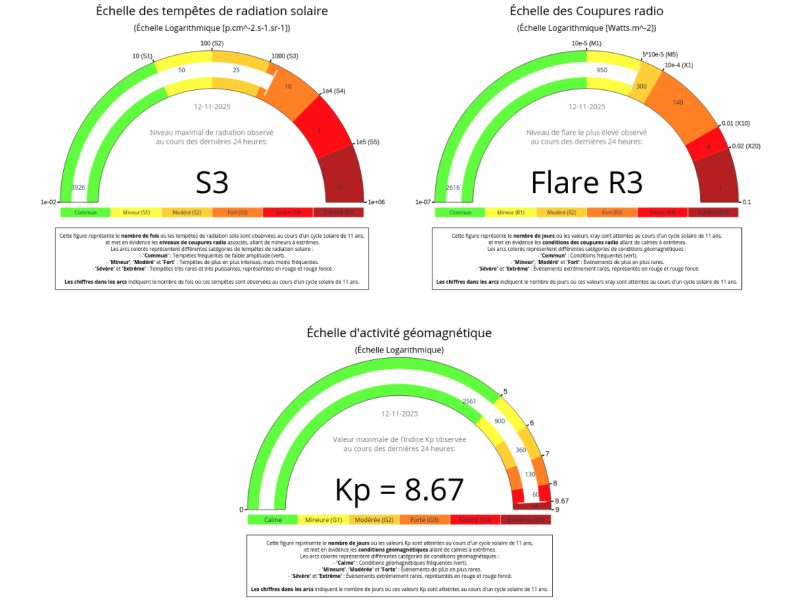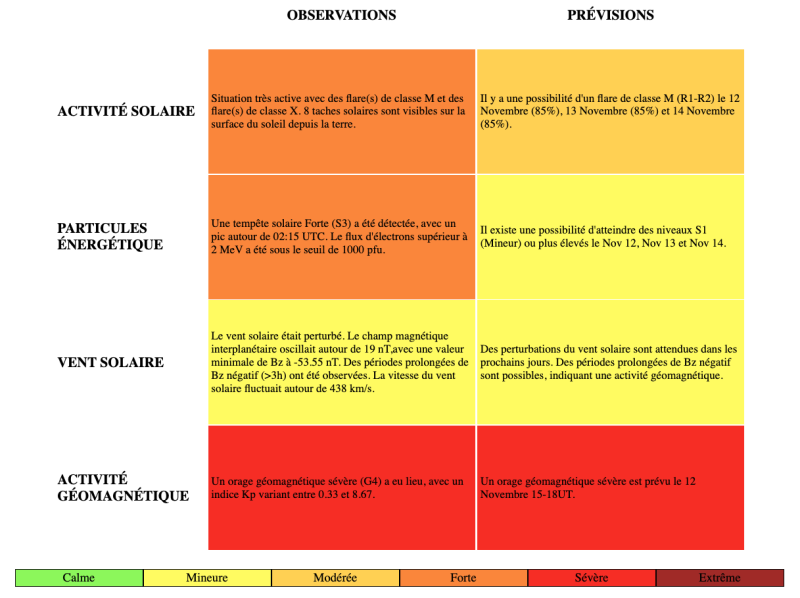Solar flares in November 2025: intense storm of energetic particles
Over the past 48 hours, solar activity has been exceptionally intense, characterized by several major class X flares. These events generated significant solar storms directed toward Earth, causing a geomagnetic storm on the nights of Tuesday, November 11, and Wednesday, November 12. The INSU National Observation Services (including our solar –BCMT– and space instruments and our MEDOC, CDPP, and STORMS, and ISGI) worked closely with the French Organization for Applied Research in Space Meteorology (OFRAME) to continuously monitor these phenomena and issue alerts to the general public and relevant stakeholders through their space weather bulletin.
Among the disturbances observed, two class X flares stand out, including one with a magnitude of X5.1, detected on November 11 at 09:50 UT by the Spectrometer for Imaging X-rays (STIX) telescope (see Figure 1), carried aboard the Solar Orbiter mission. Strong disturbances in the D region of the Earth’s ionosphere were observed in real time by the low-frequency radio antenna network, as well as a sudden and brief disturbance in the geomagnetic field by the Chambon la Forêt magnetic observatory. These flares, powerful coronal mass ejections (CMEs) and their associated shock waves, were also detected in real time by instruments at the Nançay Radio Astronomy Observatory, then by the French SoHO C2 coronagraph.
The storm of energetic particles generated by these solar events is the most intense recorded since the beginning of solar cycle 25. The energetic particles were measured at ground level by the global network of neutron monitors, with notable detection in Kerguelen and Adélie Land (the strongest increase since 2006).
The arrival on Earth of the first CMEs associated with the November 10 X-class flare, anticipated by numerical modeling by the STORMS service (see Figure 1), was marked by severe geomagnetic storms (NOAA classification of class G3 and G4). An SSC (Sudden Storm Commencement) of more than twenty nanoteslas was detected in near real time in the global network of French magnetic observatories of the SNO of the Central Bureau of Terrestrial Magnetism. The magnetic variations measured on the ground resulted in high magnetic activity indices (aa > 570 nT; am > 500 nT; Kp = 9-; Dst < -230 nT) between 01:30 and 04:30 UT on November 12, 2025 (see Figures 2 and 3).
Intense auroras were observed during the night at very low latitudes. They could be seen as far south as Aveyron in France.
Other CMEs, associated with the X5.2 flare on November 11, were expected to reach Earth on the afternoon of November 12 and during the night of November 12-13. These CMEs were observed and caused an increase in geomagnetic and auroral activity during the night.
Let us recall the risks associated with these solar storms, which cause intense geoeffectivity on the Earth’s surface and at satellite altitudes. These intense magnetic storms can cause very strong inductions in human infrastructure on the ground, such as fluid networks (electricity grids, pipelines, railways, etc.), and disrupt radio signals from satellite positioning systems (e.g., Galileo or GPS). The magnetic storm on the night of November 11 caused interruptions in HF radio transmissions. The increase in energetic particles increases the risk to satellites (mechanical erosion, degradation of satellite components and subsystems by radiation, atmospheric braking, surface currents damaging electronics, etc.) and possibly to passengers on high-altitude flights.



Laboratories involved
- Institut de Recherche en Astrophysique et planétologie (IRAP – OMP)Tutelles : CNRS / CNES / Univiversité de Toulouse
- Institut d’astrophysique spatiale (IAS – OSUPS)Tutelles : CNRS / Univ. Paris Saclay
- Institut de planétologie et d’astrophysique de Grenoble (IPAG – OSUG)Tutelles : CNRS / UGA
- Laboratoire d’Instrumentation et de Recherche en Astrophysique (LIRA -Observatoire de Paris – PSL)Tutelles : CNRS / Obersvatoire de Paris – PSL / Sorbonne Univ / Univ Paris Cité
- Institut de physique du globe de Paris (IPGP)Tutelles : CNRS / IPG / UNIV PARIS CITE
- Laboratoire de physique et chimie de l’environnement et de l’Espace (LPC2E – OSUC)Tutelles : CNRS / CNES / Univ. Orléans
- Laboratoire de physique des plasmas (LPP)Tutelles : CNRS / Ecole Polytechnique / Sorbonne Univ
- Laboratoire Astrophysique, Instrumentation, Modélisation (AIM – OSUPS)Tutelles : CEA / CNRS / Univ Paris Cité
- ONERA
- Univ. de Strasbourg
Further Resources
- Learn more about the implications with the list of all laboratories involved in the scientific coordination of OFRAME: https://meteo-espace.irap.omp.eu/oframe_team
IRAP Contacts
- Aurélie Marchaudon, aurelie.marchaudon@irap.omp.eu
- Alexis Rouillard, alexis.rouillard@irap.omp.eu
- Issaad Kacem, issaad.kacem@irap.omp.eu






